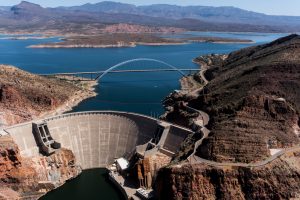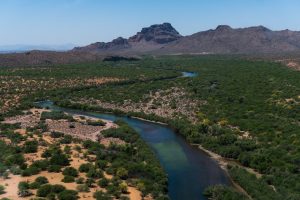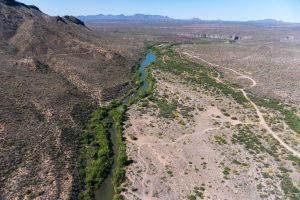- Slug: BC-CNS-Arizona Watershed, 560 words.
- Photos and captions below.
- Video here.
By NICOLE HERNANDEZ
Cronkite News
PHOENIX – Yes, it’s dry.
But Arizona’s continued lack of rain and snow doesn’t much bother Charlie Ester of the Salt River Project.
“I consider SRP to be a consummate, full time, always thinking about drought. We were formed because of drought, so therefore we always plan for drought,” said Ester, the utility’s surface-water resources manager.
Ester said SRP, the largest supplier of raw water to metro Phoenix, has enough water for its customers – despite coming off one of Arizona’s driest runoff seasons.
Officials predict that SRP reservoirs, which are fed by snowmelt from the mountains of northern and eastern Arizona, will receive record low amounts of runoff in 2018 because of a dramatically dry winter. Water managers said Arizona’s snowpack was 28 percent below normal as of March 1, according to KJZZ.
However, Arizona had a “wet” year in 2017, and SRP stored much of that runoff for future use.
SRP, which serves a 375-square-mile service area, works to sustain Arizona’s water supply by constantly moving water between its seven reservoirs in north-central and eastern Arizona. That ensures the smaller reservoirs don’t overflow during wet seasons.
During a helicopter tour in April, SRP officials pointed out the “bathtub rings” on many reservoirs, which indicate lower water levels.
However, an empty or low reservoir does not signal a crisis, officials said. SRP officials said it is normal for water levels to fluctuate dramatically depending on the time of year.
“We’re really trying to be a good steward of all the water resources we have available to us so that we can ensure our water future,” Ester said, “because we don’t know when droughts are going to be worse, or when they’re coming.”
Despite the decades-long drought, Ester said the state still must prepare for any water circumstance, such as having too much at once.
“Drought is just one end of the hydrologic spectrum,” he said. “We’ve also got to be ready for flood events, and as a hydrologist, I like the flood events better, but most of my career has been dealing with this drought that we’re in.”
Metro Phoenix primarily gets its water from three sources: SRP, which brings water from the watersheds of the Salt and Verde rivers; the Central Arizona Project, which draws from the state’s allotment of Colorado River water and groundwater; and wells. Each source is interconnected.
In addition, Phoenix and other cities also use reclaimed effluent for golf courses, parks and to recharge aquifers.
Tom Buschatzke, director of the Arizona Department of Water Resources, said about 17 percent of the surface-water supply in the state comes from rivers within Arizona.
Ester said he has has seen a significant drop in Phoenix’s water use, similar to other cities across the country.
But protecting Arizona’s water supply remains the priority for SRP, a quasi-municipality established by federal law in 1902 that also provides electrical service to central Arizona.
“Water is pertinent to the land and it belongs to the land,” Ester said. “People don’t own the water, it belongs to the land. So we deliver what is both needed but in the rights of the land to take that water.”
This story is part of Elemental: Covering Sustainability, a new multimedia collaboration between Cronkite News, Arizona PBS, KJZZ, KPCC, Rocky Mountain PBS and PBS SoCal.
Connect with us on Facebook.
For more stories from Cronkite News, visit cronkitenews.azpbs.org.
^_=




